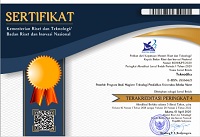Portrait of Online Learning during the Covid-19 Pandemic (a Case Study on Solo Raya Vocational Teacher)
Abstract
Keywords
Full Text:
PDFReferences
Babbie, E.R. (1975). The Practice Of Social Research. California: Wadsworth Publishing.
Belaya, V. (2018). The Use of e-Learning in Vocational Education and Training ( VET ): Systematization of Existing Theoretical Approaches. Journal of Education and Learning, 7(5), 92–101. https://doi.org/10.5539/jel.v7n5p92
Bloom, P. (2016). Against Empathy – The Case for Rational Compassion. London: The Boldey Head
Bosma, N., & Kelley, D. (2019). Global Entrepreneurship Monitor –2018/2019: Global Report
Cameron, R., (2009). A sequential mixed model research design: design, analytical and display issues. International Journal of Multiple Research Approaches , 3 (2), 140-152
Code, J., Ralph, R., & Forde, K. (2020). Pandemic designs for the future: perspectives of technology education teachers during COVID-19. Information and Learning Science, 121(5–6), 409–421. https://doi.org/10.1108/ILS-04-2020-0112
Cohen, L., Manion, L., Morrison, K. (2007). Research Methods in Education. 6th Ed. London: Routledge
Coopasami, M., Knight, S., & Pete, M. (2017). e-Learning readiness among nursing students at the Durban University of Technology. Health Sagesondheid, 300-306.
Darmalaksana, W. (2020). WhatsApp Kuliah Mobile. Bandung: Fakultas Ushuluddin UIN Sunan Gunung Djati.
Dominowski. (1980). Research Methods, Englewood Cliffs: Prentice-Hall Inc.
Evans, C. (2008). "The effectiveness of m-learning in the form of podcast revision lectures in higher education", Computers & Education, 50 (2), 491-8.
Gay, L.R. (2005). Research Methods. New York: Prentice Hall Inc.
Hakim, M., & Mulyapradana, A. (2020). Pengaruh Penggunaan Media Daring dan Motivasi Belajar Terhadap Kepuasan Mahasiswa Pada Saat Pandemi Covid-19. 4(2), 154–160.
Hayes D et.al. (2000). Integrating Computer-Based Learning in Schools: Findings from Research in Six NSW Government Schools. Paper presented at the Australian Association of Research in Education (AARE) Annual Conference, University of Sydney, 4 – 7 December 2000.
He, W., Xu, G., & Kruck, S. (2014). Online Education for the 21st Century. Journal of Information Systems Education.
Hocheng, H. (2018) . Crossing-border Journey of e-learning in higher education. A keynote
Hussin, A.A. (2019). Education 4.0 Made Simple: Ideas For Teaching. International Journal of Education & Literacy Studies, 6 (3), 92-98.
Jamaluddin, Dindin and Ratnasih, Teti and Gunawan, Heri and Paujiah, Epa. (2020). Pembelajaran daring masa pandemik Covid-19 pada calon guru: hambatan, solusi dan proyeksi. Jurnal Sains Matematika dan Statistika, 7 (1), 65-74.
Jarboe, P.K. (2005). The Changing Contexs of Higher Education and Four Possible Futures for Distance Education. University of Minnesota
Kuntarto, E. (2017).“Keefektifan Model Pembelajaran Daring Dalam Perkuliahan Bahasa Indonesia Diperguruan Tinggi” Journal Indonesian Language Education and Literature ( ILEAE), 3 (1).
Lamberton, C.M, Leana, C.R., and Williams, J.M. (2013). Measuring Empathetic Care: Development and Validation of a Self-Report Scale. Journal of Applied Gerontology, 34 (8), 1028-1053.
Mangundayao, A.B., Briones, S.J. & Mefragata, J.D. (2003). Sustaining Technician Education in the Age of Globalization. Research Report: Technological University of the Philippines.
Mathias, D. (2019): Researching Educational Apps: Ecologies, Technologies, Subjectivities and Learning Regimes. Journal Learning, Media and Technology. Vol. 44. Issue 4. DOI:S10.1080/17439884.2019.1667824.
Merriam, S.B. (2009). Case Study Research in Education: A Qualitative Approoach. San Francisco: Jossey-Bass Publishers.
Palvia, S., Aeron, P., Gupta, P., Mahapatra, D., Parida, R., Rosner, R., & Sindhi, S. (2018). Online Education: Worldwide Status, Challenges, Trends, and Implications . Journal of Global Information Technology Management
Panigrahi, R., Srivastava, P. R., & Sharma, D. (2018). Online learning: Adoption, continuance, and learning outcome—A review of the literature. International Journal of Information Management, 43, 1-14.
Purwanto, A., Akbari, M., Fahlev, M., Mufid, Eva Agistiawati, A., Cahyono, Y., & Suryani, P. (2020). Impact of Work From Home (WFH) on Indonesian Teachers Performance During the Covid-19 Pandemic: An Exploratory Study, International Journal of Advanced Science and Technology, 29 (5), 6235 – 6244.
Salgues, B. (2018). Society 5.0 – Industry of the future, technologies, methods, and tools. Volume 1. London: John Wiley & Sons Inc.
Sankey, M., Birch, D., & Gardiner, M. (2011). The impact of multiple representations of content using multimedia on learning outcomes across learning styles and modal preferences. International Journal of Education and Development using ICT, 7 (3), 18-35.
Scheier, M. F., & Carver, C. S. (2013) . Self-Consciousness Scale speech in eLFA 2018 (e-Learning Forum Asia 2018 "e-learning for the future", National Taipei University Of Bussines, Taipei, Taiwan.
Sobron, A. N., Bayu, Rani, & Meidawati, S. (2019). Persepsi Siswa dalam Studi Pengaruh Daring Learning Terhadap Minat Belajar IPA. Jurnal Pendidikan Dan Multikulturalisme, 1(2), 30–38.
Syarifudin, A. S. (2020). Implementasi Pembelajaran Daring untuk Meningkatkan Mutu Pendidikan Sebagai Dampak Diterapkannya Social Distancing. Metalingua Jurnal Pendidikan Bahasa Dan Sastra Indonesia, 31–34.
The Star. 2020. Transitioning to the new normal in education, https://www.thestar.com.my/opinion/letters/2020/04/28/transitioning-to-the-new-normal-in-education. diakses tgl. 31 Mei 2020.
Treacy, P., Prendergast, M., O'Meara. (2019). A "new normal": Teachers' experiencees of the day-to-day impact of incentivising the study of advanced mathematics. Journal in Mathematics Education. DOI:10.1080/14794802.2019.1668832
Wargadinata, W., Maimunah, I., Dewi, E., & Rofiq, Z. (2020). Student's Responses on Learning in the Early COVID-19 Pandemic. Tadris: Jurnal Keguruan Dan Ilmu Tarbiyah, 5(1), 141–153. https://doi.org/10.24042/tadris.v5i1.6153
World Economic Forum. (2018). The Future of Jobs Report 2018. In Weforum.org. https://doi.org/10.1177/0891242417690604
Refbacks
- There are currently no refbacks.





.png)













